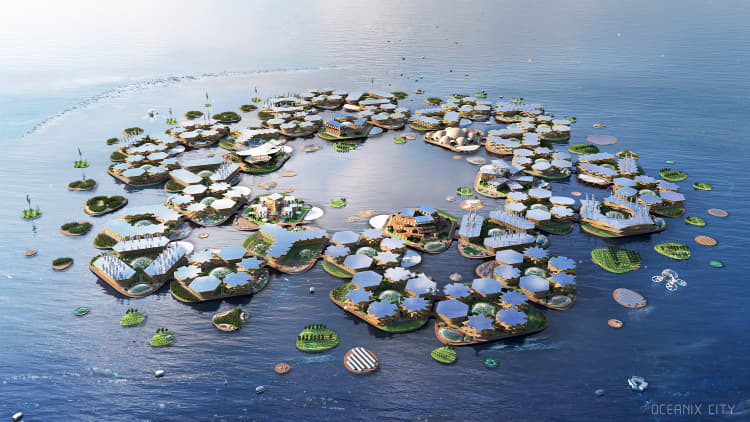People photographed in Lower Saxony, Germany, on July 19, 2022. A number of European countries were affected by a heatwave last month.
Julian Stratenschulte | Picture Alliance | Getty Images
Global efforts to respond to climate change are so far insufficient, so it’s time to begin studying technologies to reflect sunlight away from the Earth to cool it down temporarily, said a new report from the United Nations published on Monday.
Reducing greenhouse gas emissions is the only way to permanently slow global warming, but global efforts to reduce greenhouse gas emissions are currently “not on track to meet the 1.5° Celsius Paris Agreement goal,” the UN Environment Program said in a written statement accompanying the release of the report.
So, because the world is not responding to climate change urgently enough, a “speculative group of technologies” to reflect sunlight back away from the earth has been getting more attention lately, the UNEP said in a written statement accompanying the report. This category of technologies is often called “solar radiation modification” or sometimes “solar geoengineering.”
The report on these technologies, written by an expert panel brought together by the UNEP, finds that it is categorically not a good idea right now to use any technologies that reflect sunlight away from the Earth in an effort to respond to climate change.
However, “this view may change if climate action remains insufficient,” the report says. That means it’s time for rigorous study of the technology and its potential international governance.
A similar message came from a group of more than 60 scientists in an open letter that was also (coincidentally) published on Monday.
Fast and doable, but potentially dangerous
Solar geoengineering “is the only known approach that could be used to cool the Earth within a few years,” the UN report says, and would cost tens of billions of dollars per year per degree of cooling.
While the technology to inject large quantities of aerosols into the upper atmosphere does not exist today, it’s not terribly complicated: “no show-stopping technical hurdles have been identified,” the UN report says, and it could be “developed in under ten years.”
Scientists know it works quickly because the global average temperature of the planet has fallen after large volcanic eruptions have spread large quantities of aerosols into the upper atmopshere. These observations of volcanos “provide strong evidence that a deliberate injection of large amounts of reflective particles into the stratosphere would cool the Earth rapidly,” the UN study says.
“If global warming at some point produces outcomes widely seen as intolerable (e.g. widespread famines, mass migration, mass mortality and destruction of infrastructure) an operational SRM deployment as part of a ‘planned’ emergency response might be able to alleviate some of this suffering within a few years,” the UN report finds.
But the techniques can also be dangerous.
For example, sulfur dioxide is commonly proposed as an aerosol, but would result in acid rain, the UN report says. It could increase ozone depletion. Specifically, “Antarctic ozone hole recovery could be delayed by a couple of decades and the ozone hole could become deeper in the first decade of SAI deployment,” the UN report says.
So solar geoengineering could be considered as a one-time shot to mitigate extreme suffering and death caused by climate change.
Or sunlight reflection technology could become part of a “phased” longer-term strategy to buy more time to aggressively and permanently reduce greenhouse gas emissions.
The risk of rogue actors
Regardless, we just don’t know enough about the side effects.
“We only have one atmosphere. We cannot risk further damaging it through a poorly understood shortcut to fixing the damage we already caused,” wrote Inger Andersen, the executive director of UNEP, in a forward to the study.
And right now, there is not enough reliable information to make an informed decision, the UN study finds.
“The review finds that there is little information on the risks of SRM and limited literature on the environmental and social impacts of these technologies,” Andersen wrote. “Even as a temporary response option, large-scale SRM deployment is fraught with scientific uncertainties and ethical issues. The evidence base is simply not there to make informed decisions.”
In addition to needing a rigorous scientific study, the UN report also says there needs to be an international coordinated governance strategy for any potential use of solar geoengineering technology.
Because it can be deployed for as little as $20 billion per one degree Celsius of cooling per year, sunlight radiation technologies are “within reach” of many countries and organizations, opening the possibility of a “rogue deployment,” the UN report says.
The United Nations could be a leader in global discussions of solar geoengineering conversations, the report said.
The consequences of not having international cooperation and governance is potentially dire.
“One can assume that there will never be universal consensus in the broader community on an SRM deployment, which means that communities, nations and societies opposed to SRM deployment would be exposed to its effects against their wishes, raising ethical and legal concern.”

 EU News Digest Latest News & Updates
EU News Digest Latest News & Updates



